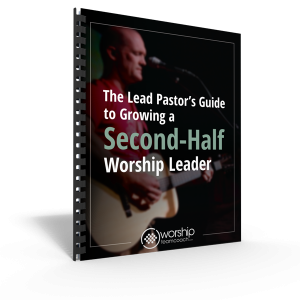A Tough Conversation
(The following story is a composite of several similar conversations I’ve had with senior/lead pastors. All names and details have been fictionalized to protect their identity.)
Eric’s coffee was getting cold. He had lost interest in it shortly after I asked him how his church’s worship ministry was going.
As the senior pastor of a church that is hovering between 900 and 1000, Eric oversees a staff of five full-time pastors, several part-time pastors or directors, along with multiple support staff.
One of those full-time pastors is Brad, Eric’s long-time worship pastor. And Brad’s the reason the coffee’s being ignored.

Eric said to me, “We do some current songs, but they just don’t sound, well, current. He has a way of making every week feel like a throwback Sunday.”
He went on, “We have a few younger people in the worship ministry, but the average age of the team is getting older every year.
“In fact, I’m guessing that online visitors to our live stream replay probably think we cater to the empty-nesters and the retired crowd. But we have a healthy population of 20- and 30-somethings. Unfortunately, I’m afraid we might lose them.
“I’ve heard it from some of our 20-somethings—they’re decidedly NOT attending for the music.
“You know, I truly don’t think we’re idolizing youngness,” he said, “We just want to connect with those in their 20s and 30s. Brad just doesn’t seem open to creating a younger feel.”
He stared at his lukewarm coffee for a moment, then looked up at me, “I’m just not sure what to do.”
I decided to go straight at it. “Do you feel it’s time to let him go?”
“Not really—I mean, the last thing I want to do is fire him,” Eric replied. “He’s a great musician and worship leader, and he leads the team really well. Most over the age of fifty love him.” And pretty much everyone at our church likes him—even those that don’t like his musical choices.”
Eric hesitated, and finally added, “But I’m not sure how long I can let this go on.”
No-Win Situation
Unfortunately, Eric is not in an unusual situation. So many senior pastors are struggling with this seemingly no-win situation: be accused of ageism, or neglect your younger generations.
As a senior pastor, you see and appreciate the maturity and leadership depth that an older worship leader brings.
But there can be a disconnect with the younger generation when it comes to musical styles, song selection, and the involvement of younger leaders and team members.
Not every ‘older’ worship leader is like “Brad.” So let me list for you different types of aging worship leaders. You’ll probably see your aging worship leader fits at least one of these types on this list:
(By the way, I’ll be using gender-specific terms just for writing clarity. But just know that any of these types could be either male and female leaders.)
Aging Worship Leader Archetypes
The Cluelessly-Aging Worship Leader
This is the worship leader who doesn’t sense the widening gap between him and the younger generation. He just continues to do what has worked for him for years.
Often times, he thinks he’s still relevant and hip.
The Arrogantly-Aging Worship Leader
This worship leader sees the age gap and has almost a disdain for the younger generation.
She writes them off as too…
- emotional…
- naive…
- performance-driven…
- idealistic…
- …and of course, immature.
Often times, her biggest complaint about the younger generation is their entitlement and over-confidence—which she, ironically, labels arrogance.
The arrogantly-aging worship leader will delegate some leadership to younger-generation leaders, but only within tight boundaries. She doesn’t fully trust them to lead to her standards.
Then there’s everyone’s favorite:
The Trying-Too-Hard Worship Leader
This worship leader knows he’s getting older and is desperately trying to stay relevant—even to the point where it’s sadly comical.
He introduces the new songs and tries to keep up on the latest styles—both with music and fashion. But none of it seems genuine. (Especially the bad dye job.)
Likely, this compulsive pursuit of youthfulness is fueled by a fear of losing his job. He feels he has to “stay relevant” to stay employed. Unfortunately, in many churches, he might be right.
The Worn-Out Worship Leader.
This leader has been leading 45 – 50 weeks a year for the better part of the last two decades and is…Just. Plain. Tired.
She’s tired of the Sunday-after-Sunday grind.
What once was life-giving (planning, preparing, and leading Sunday services) is now drudgery. Keeping up with new musical styles and songs is also no longer fun.
She loves her team and loves her church, but she’s not sure how much longer she can do this.
And lastly, there’s the almost-unicorn in the modern worship leading world.
The Foot-In-Both-Worlds Worship Leader
He’s a middle-aged worship leader full of vitality who bridges the gap between generations astonishingly well.
He’s stayed appropriately modern in both appearance and musical styles. He connects well with those decades younger than him, but he still has a great rapport with the generation above him.
Honestly, those of us who around his age are a little jealous of how well he’s aging.
But, there’s a dark side to the Foot-In-Both-Worlds Leader.
He can allow the perception of his youthfulness and his rapport with younger people to cloud a year-after-year, slow-growing, disconnect between himself and the generations below him.
AND, it keeps him from progressing to the “next level” of ministry leadership, which every experienced worship leader should ascend to. (We’ll talk about that level in a moment.)
Now, you might see that more than one of those archetypes partially fit your worship leader. And you’re right.
Your aging leader is a complex mixed-bag of strengths and weaknesses, experiences and woundings, and self-knowledge and blindspots.
But hopefully, I’ve given you some language and ‘handles’ to express what you’ve been feeling. So now you’re probably wondering, “Is there an ideal older worship leader?”
Yes. He or she is what I call the “Second-Half Worship Leader.”
The Second-Half Worship Leader
Let me give you some character traits for the second-half worship leader.
Guide Vs. Hero
If we look at a worship leader in the context of “the hero’s journey,” the second-half worship leader has taken on the mantle of the guide instead of the hero. She’s about helping others succeed and grow.
It’s kinda like the young Luke Skywalker moving from a hotshot pilot and Jedi-in-training to the old Luke Skywalker. Old Skywalker no longer needs the hero title but becomes a guide and mentor to a new generation of Jedi.
The second-half worship leader moving from hero to guide might look like this:
- She shares the platform leadership with others. There will even be weekends where she’ll play a “back row” or BGV role, or be off the platform entirely.
- He’s investing increasingly more time and budget money into developing leaders and team members.
- She’s at least thinking about (or even actively working towards) a seamless succession to another leader (and might already have a successor in mind).
Kingdom Legacy
Another trait of a second-half worship leader is a focus on legacy and Kingdom impact.
The second-half leader still plans and delivers high-quality worship sets each week, but he’s becoming less concerned about ‘this Sunday’ and ‘next Sunday.’ He desires to build something that will last far beyond him.
And this long-term work is about legacy, but it’s not a self-focused legacy.
He’s concerned about the future of your church. Long after people have forgotten him, the second-half leader prays that the seeds that he planted will continue growing.
Those seeds include multiplying his ministry by developing other leaders. He’s ultimately about the Kingdom and takes 2 Timothy 2:2 to heart.
Generation Bridge
The second-half worship leader bridges the generation gap—in both directions—without trying to be all things to all ages.
She’s is aware of modern trends in music and church and works to stay relevant, but understands that she needs to surround herself with younger leaders and team members to truly bridge the age gap.
As a result, she embraces multi-generational teams. In this, she encourages the younger generations to appreciate the hymns and older worship music that’s paved the way for their music.
But she also pushes the older crowd to stay current.
More Than Music
The second-half worship leader also loves the people of the church far more than the music they sing or how they sing it.
He’s more concerned that the church is worshiping together through music, and is less concerned about singing the hippest new songs.
He’s also actively helping the church understand the biblical definition and practice of worship—which goes WAY beyond music. The second-half worship leader wants to help the church move away from the modern and shallow view that the “Sunday-song-time equals worship.”
Balancing the Old and New
The second-half worship leader understands the need to rotate in current songs, so she taps into her younger leaders and team members for new song suggestions.
Many of these songs wouldn’t be her first choice. But if they pass her other criteria for inclusion in the rotation (congregational sing-ability and biblically-based lyrics), she forgoes personal preference and trusts her younger leaders’ instincts.
But she balances those new songs with the ‘heart-songs’ of the church. That is, those songs that the congregation knows intimately and “sings from the heart” instead of just “singing from the screen.”
As a result of wanting both old and new, she practices a limited rotation of songs—knowing the team and church can only truly know so many songs. So her limited rotation philosophy will never please everyone, and she’s OK fighting that battle.
Some in the congregation (not always the younger crowd) will continually want more new songs. Others are happy to keep singing the same ones over and over.
So she manages a healthy tension of bringing in new songs and retiring old ones—even ones that are her personal favorites.
Team Culture vs. Talent Pool
A second-half worship leader is less concerned about stacking talent on his team than building a healthy team culture.
He’s learned the hard way that toxic will always trump talent.
That is, a team member’s talent (no matter how considerable) will never be enough to overcome a toxic personality (arrogance/ego, heart issues, entitled, etc.).
The second-half leader wants to build a worship ministry with an incredible team culture. Because of that he identifies and works to overcome dysfunctional team behavior—even to the point of asking some people to step down, and then saying no to talented but toxic musicians when they audition.
And more than ever in his tenure as a worship leader, he’s concerned with the spiritual walk of his team members. He knows their platform worship will never exceed their private worship. So he’s shepherding them to be worshipers of Jesus first, church musicians second.
Loves the Church
The second-half leader does not hide out in the green room but instead is connecting with her church family before, after, and between services. She’s committed to the vision of the church, follows the senior pastor’s lead, and loves the people she leads each Sunday.
Leads Leaders
The second-half worship leader spends less time doing the work of ministry and instead equips others to do ministry and lead.
He also recognizes that his team needs a plurality of leaders with different gifts, backgrounds, and experiences, so he works to create that diversity.
In other words, he takes Ephesians 4:11-12 seriously.
People and Processes
The second half leader sees the need for efficient systems and processes but hasn’t let that replace the organic and relational side of ministry. In fact, she leverages systems so she can be more people-focused.
She has also overcome her own strength/weakness mix when it comes to people vs. tasks.
If she’s wire to be more task-oriented, she’s learned to value spending time with her team and leaders. But to overcome that even more, she’s raised up shepherds to help her nurture the team.
And if she’s naturally more people-oriented, she’s learned to embrace systems and processes, while surrounding herself with administratively strong leaders and team members who balance her.
And as the second half-leader grows, she gets ultra-intentional about renovating her ministry systems, so they’re not just efficient, but they’re learnable and repeatable.
That is, she’s always working toward healthy delegation of the work of ministry to her other leaders.
What If You Don’t Have a Second-Half Worship Leader?
So after that list, even the best worship leader thinks, “Dang, I’m not even close.” And as a senior pastor, you might be wondering where you’d ever find one of these kinds of leaders.
But remember, this is the “ideal” second-half worship leader. If you’ve got a leader who’s at least making progress in those traits, you’ve got something to work with.
But what if you don’t?
What if you have a leader who displays too many traits of one or more of these kinds of leader.:
- The Cluelessly-Aging Worship Leader
- The Arrogantly-Aging Worship Leader
- The Trying-Too-Hard Worship Leader
- The Worn-Out Worship Leader
- The Foot-in-Both-Worlds Worship Leader
As a lead pastor, what do you do? What if you’re like Eric who’s doesn’t want to fire Brad, his middle-age worship leader, but he’s not sure how long he can let neglect the younger generation.
As a leader of a church, you’re more than capable of navigating staff and leadership issues.
But we both know that the worship/music ministry leader can be a “different breed of cat.” So I wanted to give you some guidelines and handles for dealing with an older leader who’s not moving towards “second-half” maturity.
 I’ve put together a guidebook with practical steps that you can take, as well as questions that will start a healthy conversation with your worship leader. It’s called The Lead Pastor’s Guide to Growing a Second Half Worship Leader.
I’ve put together a guidebook with practical steps that you can take, as well as questions that will start a healthy conversation with your worship leader. It’s called The Lead Pastor’s Guide to Growing a Second Half Worship Leader.
To get the guidebook, click this link and let me know where to send your packet. I also ask a couple simple questions to understand better to help senior pastors like you better. I’d love to hear from you.
It’s fantastic that you’re investing time and energy into leading and shepherding your worship leader! If my team or I can be of help to your situation, please reach out. I’d love to connect.
And again, get the Growing a Second Half Worship Leader Guidebook. It’s fantastic starting point for your crucial conversations ahead.
Stuck?
Learn how to level-up your team with this free video training.







